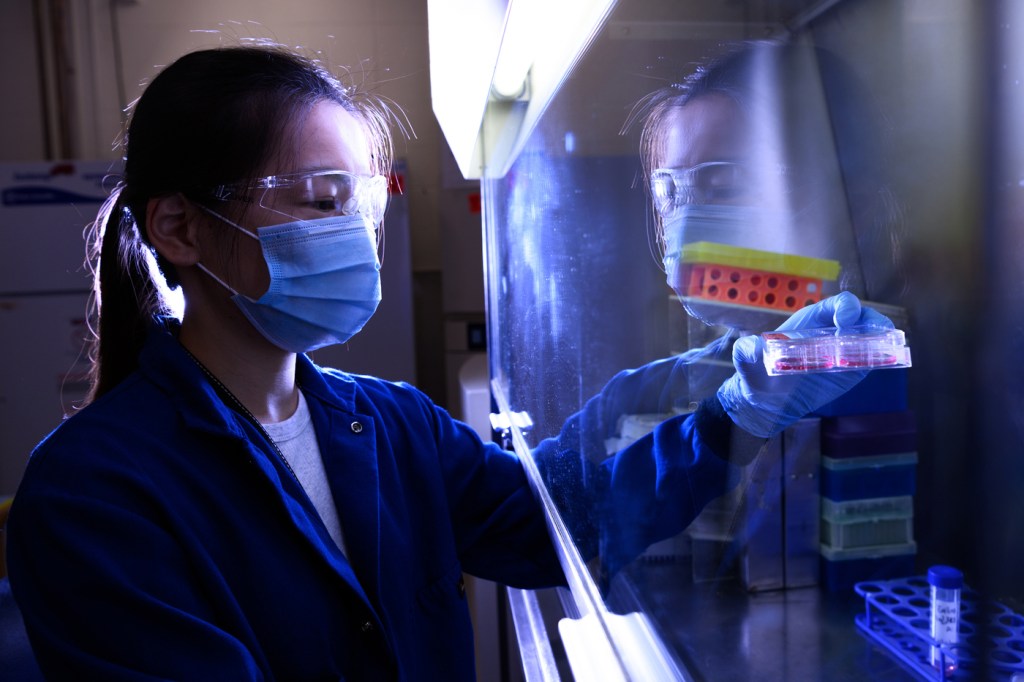‘It’s notoriously difficult to treat.’ Northeastern scientists developing a better treatment for pancreatic cancer

Pancreatic cancer is one of the most deadly of malignancies, with a five-year survival rate of 11%.
The American Society of Clinical Oncology says nearly 50,000 men and women in the United States die from the disease annually, making it the fourth leading cause of cancer death in the country.
Now scientists from Northeastern University are partnering with UC Davis and drug developer TargaGenix on the final research stages of a new therapeutic model they say could transform treatment for pancreatic cancer and potentially save thousands of lives every year.
The researchers, who recently received a $3 million five-year grant from the National Institutes of Health, will work on mouse efficacy and safety trials at Northeastern for the next three years.

If all goes well, the next step is to start clinical trials in years four and five on pancreatic cancer patients at the UC Davis Comprehensive Cancer Center.
“It’s not just testing it in mice and then coming out and saying, ‘We’ve cured a lot of mice,’” says Mansoor Amiji, distinguished professor of pharmaceutical sciences and chemical engineering at Northeastern and a lead investigator on the NIH study.
“Now we want to see that this can actually happen in the clinic. That’s why the UC Davis collaboration is so important. They have a hospital and are actually treating pancreatic cancer patients,” says Amiji, who is also the scientific adviser for TargaGenix, now known as Recurv Pharma.
The treatment already has successfully killed pancreatic cancer cells in tumors grown in the laboratory in a variety of preclinical cancer models.
It uses a type of nanoparticle technology called nanoemulsion, which Amiji says was patented at Northeastern, to deliver a novel and potent chemotherapy agent, TGX-1214, to pancreatic cancer tumors.
The challenge posed by TGX-1214 is that it is soluble in oil, not water, the medium by which chemotherapy typically is delivered intravenously, Amiji says.
Nanoemulsion solves the problem by slipping the chemotherapy drug into tiny droplets the size of a nanometer made with fish oil suspended in water, he says. These droplets—which are not visible to the naked eye—carry the drug to the site of action, enhancing efficacy and reducing toxicity.
“Emulsion is a fancy word for salad dressing—basically it’s an oil and water mixture, where the oil droplets are down to the nanometer size,” Amiji says.
“It’s a targeting mechanism for getting the drug to the tumor.”
The researchers found that the delivery system has additional benefits in that it enhances immunotherapy treatments occurring simultaneously with chemotherapy, Amiji says.
Immunotherapy uses the body’s own defenses to fight malignant cells. In this case, TGX-1214 administration increases the anti-tumor immune response of a natural suppressor called the checkpoint blockade.
But unlike TGX-1214 with its small molecules, antibody molecules are too large to penetrate fibrous mats created by pancreatic cancer cells.
The mats act like shields for malignant tumors, Amiji says.
The nanoemulsion delivery of the chemotherapy agent kills the fibrous material, clearing the path for antibodies and allowing them to penetrate deeper into the tumor tissue, he says.
“You’re using a synergistic approach to treat pancreatic cancer patients, as opposed to single therapy,” Amiji says. “You’re making the antibody work better when you combine it with the small molecule chemotherapy agent.”
The drug therapy targets pancreatic ductal adenocarcinoma, which accounts for 90% of pancreatic cancer cases, Amiji says. He says TargaGenix is providing the TGX-1214 chemotherapy agent to researchers free of charge.
It’s exciting to partner with UC Davis for a chance to see how the drug delivery system works in actual pancreatic cancer patients, Amiji says.
“We work with mice and we work with cells and then we usually stop,” he says. “These types of collaborations really help us to move along.”
UC Davis researchers say surgery and existing chemotherapy treatments have failed to prevent pancreatic cancer patients from relapsing at high rates.
“Surgery, which offers the only realistic hope for a cure, is a viable option in only a limited number of patients, and current chemotherapy and radiation therapy offer limited or no benefit at all,” UC Davis pancreatic cancer researcher Gerardo Mackenzie says, according to a UC Davis press release.
“The average survival in advanced disease is still less than a year,” according to Dr. Edward J. Kim, UC Davis oncologist and medical director of the cancer center’s Office of Clinical Research.
The Mayo Clinic says pancreatic cancer is seldom caught at early stages when it is most curable because it doesn’t usually cause symptoms until it has spread to other organs.
“It’s notoriously difficult to treat,” which is why there is such a need for new treatment delivery systems, Amiji says.
He says that James Egan, CEO of TargaGenix—now Recurv Pharma—told him several years ago he was working with a chemist, Dr. Iwao Ojima, at Stony Brook University in New York to develop TGX-1214. The chemotherapy agent is a taxane, a drug that stops cell growth by inhibiting cell division.
“Usually, in drug development, you try to make drugs soluble in water,” Amiji says.
“Ninety percent of blood is water, and you want to use blood as a conduit to ferry your drug to different parts of the body.”
“In this case, it was an interesting paradox, because the drug was very, very effective. But it was also incredibly insoluble in water. Dr. Ojima’s team synthesized the compound and then he added a fatty acid chain to it to make it even less soluble, to improve potency,” Amiji says.
Realizing that the nanoemulsion method developed at Northeastern could be key to taxane’s delivery system, Amiji says in collaboration with TargaGenix, they got a Small Business Innovation Research grant from the National Cancer Institute that allowed him to hire several postdocs to start work on the pancreatic cancer project.
Mackenzie and Kim joined him and Egan in applying for the latest grant, from the NIH, Amiji says.
He says the nanoemulsion delivery of chemotherapy has other benefits, such as allowing more targeted treatment of cancer by better distinguishing between malignant and healthy cells.
“Tumors generally have high metabolic rates. They’re rapidly dividing cells. They want to eat as much as possible,” Amiji says.
Tumors see oil as food, but in the nanoemulsion delivery of chemotherapy, the oil is a Trojan horse, he says.
“We’re fooling the tumor to think you’re giving it a nutrient, but inside it, you have a cytotoxic drug. The cell takes it up and dies from it.”
Amiji says the drug-infused oil is only attractive to malignant cells and is not taken up by healthy cells, reducing many of the side effects so often associated with chemotherapy.
Cynthia McCormick Hibbert is a Northeastern Global News reporter. Email her at c.hibbert@northeastern.edu or contact her on Twitter @HibbertCynthia






